You can create eco-friendly home office chairs using DIY techniques and sustainable materials. Options include upcycling wooden pallets, crafting stools from recycled cardboard, or repurposing old barrels. Natural materials like bamboo, cork, and hemp offer renewable alternatives for comfortable seating. For a unique touch, try making a biodegradable mushroom foam cushion or salvaging a tire into an ottoman. These projects not only reduce environmental impact but also allow you to customize your workspace. With a bit of creativity and some basic tools, you'll transform discarded items into stylish, functional chairs. Discover how these sustainable seating solutions can revolutionize your home office setup.
Upcycled Pallet Chair
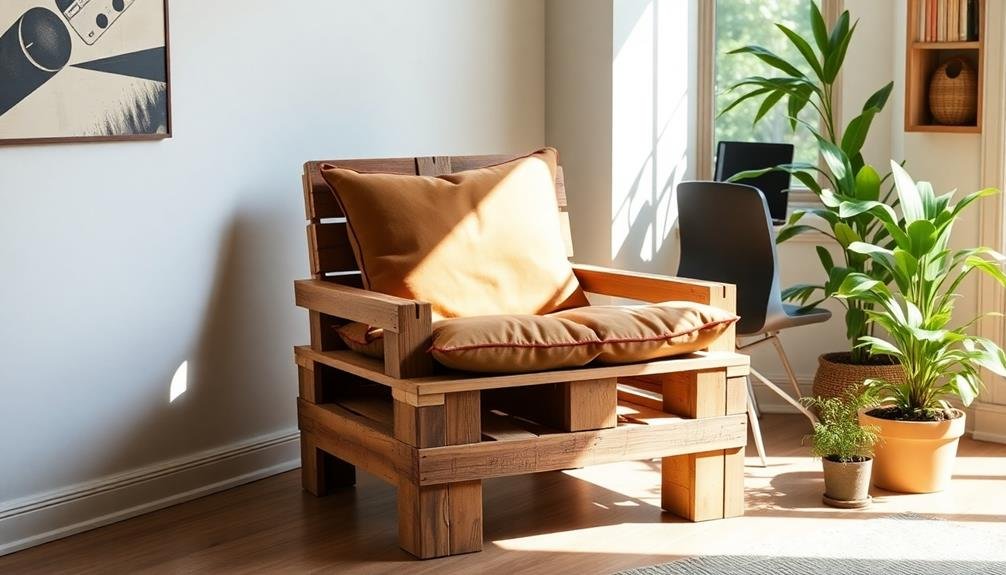
In recent years, upcycling has become a popular trend for eco-conscious DIYers. Creating an upcycled pallet chair for your home office is a sustainable and cost-effective way to furnish your workspace. You'll need a wooden pallet, sandpaper, wood stain, screws, and cushioning materials.
Start by dismantling the pallet, removing any nails or staples. Sand the wood thoroughly to avoid splinters and create a smooth surface. Arrange the pallet boards to form the seat and backrest, ensuring they're sturdy and comfortable. Secure the pieces with screws, reinforcing weak points for added stability.
Apply wood stain to protect the chair and enhance its appearance. You can choose a color that complements your office decor. For comfort, add cushioning to the seat and backrest using eco-friendly materials like organic cotton or recycled foam.
To elevate the design, consider adding armrests or a swivel base using additional pallet wood or upcycled materials. You can also personalize your chair with paint or decorative elements.
This DIY project not only reduces waste but also gives you a unique, environmentally friendly seating option for your home office.
Recycled Cardboard Stool
You'll be surprised by the durability and weight capacity of a well-constructed recycled cardboard stool.
With proper assembly techniques and reinforcement, these eco-friendly seats can support an average adult's weight.
You can customize your cardboard stool with various shapes, sizes, and decorative elements to match your home office aesthetic.
Durability and Weight Capacity
Designed for sustainability, recycled cardboard stools offer surprising durability and weight capacity. You'll find that these eco-friendly seating options can support more weight than you might expect. When constructed properly, a cardboard stool can hold up to 200 pounds or more, depending on its design and the thickness of the materials used.
The key to achieving this strength lies in the layering and folding techniques employed during construction. By creating a honeycomb or cross-braced internal structure, you'll markedly increase the stool's load-bearing capacity.
The type of adhesive used also plays an essential role in enhancing durability. Opt for strong, water-resistant glues to guarantee your stool can withstand daily use and occasional spills.
To further improve your cardboard stool's longevity, consider applying a protective coating. This will guard against moisture and wear, extending its lifespan.
While these stools may not last as long as their traditional counterparts, with proper care and maintenance, you can expect them to serve you well for several months to a year, depending on usage.
Remember to periodically check for signs of wear and replace the stool when necessary to maintain your safety.
Assembly and Customization Options
Assembling a recycled cardboard stool offers a fun and creative DIY project with numerous customization options. You'll need cardboard sheets, a utility knife, wood glue, and a cutting mat to get started.
Begin by cutting the cardboard into strips of equal width, then layer and glue them together to form the seat and legs. For added stability, consider creating a honeycomb structure within the stool's core.
Once you've built the basic form, it's time to personalize your creation. You can paint the stool with eco-friendly paints or cover it with recycled fabric for a softer touch. Add decorative elements like pressed leaves or magazine cutouts for a unique look.
If you're feeling adventurous, experiment with different shapes or incorporate storage compartments into the design.
To enhance comfort, consider adding a cushion made from organic cotton or repurposed foam. You can also adjust the height by adding or removing cardboard layers.
For a more durable finish, apply a non-toxic sealant to protect against moisture. Remember, the beauty of DIY furniture lies in its adaptability, so don't hesitate to modify the design to suit your specific needs and aesthetic preferences.
Bamboo Folding Chair
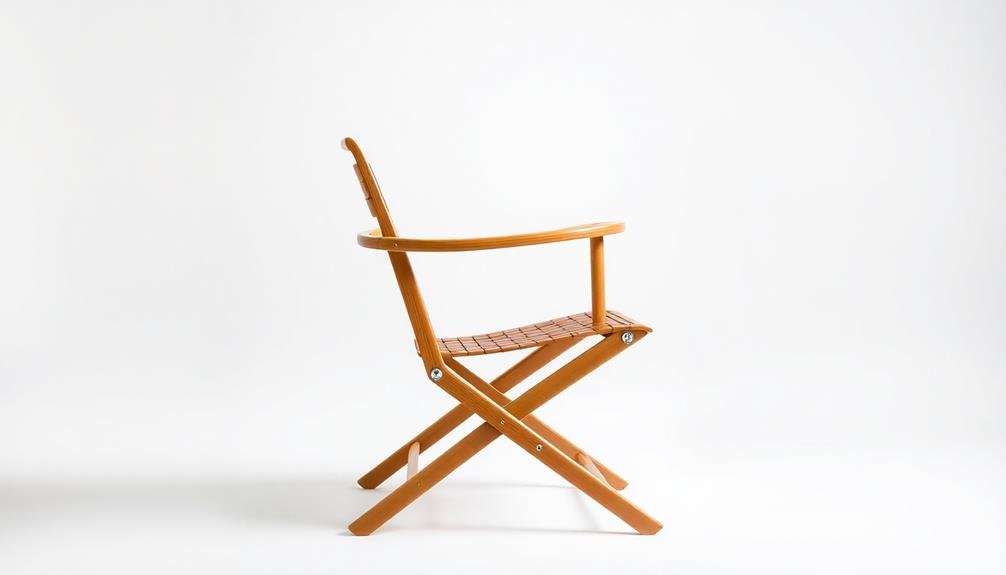
One of the most versatile and eco-friendly options for a DIY home office chair is the bamboo folding chair. You'll love how lightweight and portable this chair is, making it perfect for small spaces or multipurpose rooms.
Bamboo is a rapidly renewable resource, growing up to 3 feet per day, so you can feel good about your sustainable choice.
To create your own bamboo folding chair, you'll need:
- Bamboo poles (1-2 inches in diameter)
- Natural fiber rope or twine
- Scissors or a utility knife
- Sandpaper
- Eco-friendly wood sealant
Start by cutting the bamboo poles to size for the chair frame, legs, and seat slats. Sand any rough edges to prevent splinters.
Use the rope to lash the pieces together, creating sturdy joints and a flexible folding mechanism. For the seat, weave rope or natural fabric between the bamboo slats.
Finally, apply a coat of eco-friendly sealant to protect the bamboo from moisture and wear.
You'll appreciate the chair's natural aesthetics and its ability to fold flat for easy storage. With proper care, your DIY bamboo folding chair will provide comfortable, sustainable seating for years to come.
Cork Seat Cushion
To complement your bamboo folding chair, a cork seat cushion offers both comfort and sustainability. Cork is an excellent material choice for eco-conscious DIY enthusiasts. It's renewable, biodegradable, and harvested without harming the tree.
You'll appreciate its natural insulation properties, which keep you cool in summer and warm in winter.
To create your cork seat cushion, you'll need cork fabric, eco-friendly foam, organic cotton fabric, and non-toxic adhesive. Start by cutting the foam to fit your chair seat. Next, cover the foam with the organic cotton fabric, securing it with adhesive.
Finally, wrap the cork fabric around the cushion and attach it using eco-friendly glue.
Cork's durability guarantees your cushion will last for years, reducing waste. It's also naturally antimicrobial and hypoallergenic, making it ideal for those with sensitivities.
You can easily clean your cork cushion with a damp cloth and mild soap.
Hemp Fabric Upholstery
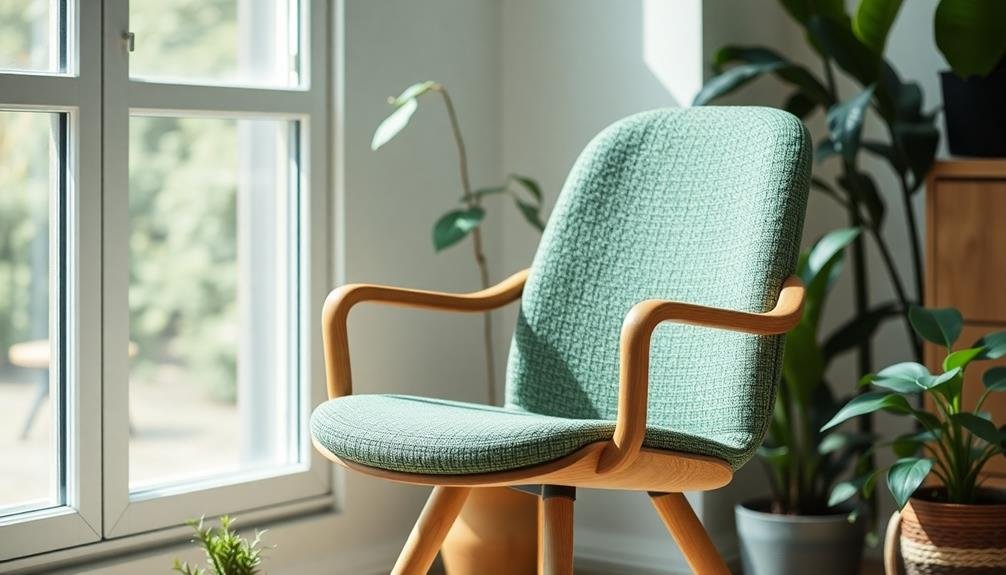
Hemp fabric offers a sustainable and durable option for upholstering your DIY office chair. It's a versatile material that's both eco-friendly and long-lasting, making it an excellent choice for your home office seating.
When working with hemp fabric, you'll find it's easy to handle and can be attached to your chair frame using a staple gun or upholstery tacks.
To get started with hemp fabric upholstery, you'll need:
- Hemp fabric in your desired color or pattern
- Scissors or fabric shears
- Staple gun or upholstery tacks
- Foam padding (optional)
- Measuring tape
Cut the hemp fabric to size, allowing extra material for wrapping around the seat and backrest. If you're adding padding, secure it to the chair frame before attaching the fabric.
Stretch the fabric tightly over the seat and backrest, securing it with staples or tacks as you go. Pay special attention to corners and curves, ensuring a smooth finish. Trim any excess fabric for a clean look.
You'll appreciate hemp's natural resistance to mold, mildew, and UV rays, which helps maintain your chair's appearance over time. With proper care, your hemp-upholstered office chair will provide comfort and style for years to come.
Repurposed Barrel Chair
You'll find creating a repurposed barrel chair both rewarding and eco-friendly.
To get started, you'll need to gather materials like a wooden barrel, foam padding, fabric, and basic woodworking tools.
Once you've prepared your barrel by cleaning and cutting it to size, you can begin assembling your unique chair and adding finishing touches for comfort and style.
Materials and Tools Needed
Creating a sustainable home office chair from a repurposed barrel requires a unique set of materials and tools. You'll need to gather specific items to guarantee a successful and comfortable DIY project.
First, source a clean, food-grade wooden barrel that's in good condition. You'll also need wood for the seat and backrest, which can be reclaimed or sustainably sourced.
For the chair's construction, you'll require:
- A circular saw or jigsaw for cutting the barrel and wood
- Sandpaper and a sander for smoothing surfaces
- Wood glue and screws for assembly
- A drill with various bits for creating pilot holes
- Upholstery materials (optional) for added comfort
Don't forget safety equipment like goggles, gloves, and a dust mask.
You'll also need measuring tools, including a tape measure and carpenter's square. If you're planning to add wheels, you'll need casters and appropriate mounting hardware.
For finishing touches, gather wood stain or eco-friendly paint, brushes, and a clear sealant to protect your creation.
With these materials and tools at hand, you'll be well-equipped to transform a barrel into a unique, sustainable home office chair.
Barrel Preparation Steps
The initial step in repurposing a barrel into a sustainable office chair is proper preparation. Begin by thoroughly cleaning the barrel, removing any residual contents and scrubbing it inside and out with a mild detergent. Rinse well and allow it to dry completely.
Next, inspect the barrel for any damage or weak spots. Sand down rough edges and patch any holes or cracks with wood filler. Once the filler has dried, sand the entire surface of the barrel to create a smooth finish.
You'll need to cut the barrel to the desired chair height. Measure and mark a straight line around the circumference, then use a reciprocating saw to carefully cut along this line. Sand the cut edge to prevent splinters.
If you're planning to add a backrest, mark and cut an additional section from the barrel. This piece will serve as the chair's back support.
Assembly and Finishing Touches
Once the barrel has been prepared, it's time to transform it into a functional chair. Start by attaching the seat to the barrel's top using strong wood screws. Make sure it's level and secure.
Next, install the backrest by cutting a piece of wood to fit the curve of the barrel and attaching it with brackets. For added comfort, consider upholstering both the seat and backrest with eco-friendly fabric.
To finish your repurposed barrel chair, you'll need to:
- Sand any rough edges for a smooth finish
- Apply a non-toxic wood stain or paint to protect the wood
- Add rubber feet to the bottom for stability
- Install armrests using reclaimed wood pieces (optional)
- Attach decorative elements like cushions or throw pillows
Don't forget to seal any exposed wood with a natural, low-VOC sealant to protect it from moisture and wear.
Reclaimed Wood Rolling Chair
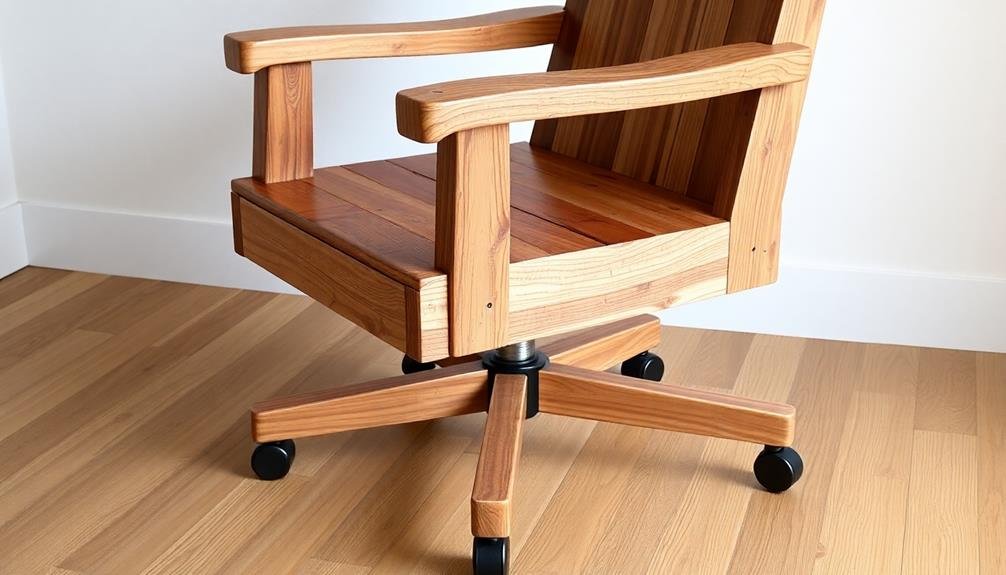
Frequently overlooked, reclaimed wood can transform an ordinary office chair into a sustainable masterpiece. To create your own reclaimed wood rolling chair, start by sourcing weathered planks from local salvage yards or construction sites. Choose pieces with character, like nail holes or knots, to add visual interest.
Begin by disassembling an old office chair, keeping the base, wheels, and adjustable mechanism intact. Cut the reclaimed wood to fit the seat and backrest, sanding rough edges for comfort. Use wood glue and screws to securely attach the planks to the chair's frame.
For added durability, apply a non-toxic sealant to protect the wood from spills and wear. You can customize the chair further by adding a cushion made from organic cotton or recycled fabric.
Don't forget to oil the wheels and adjustment mechanisms for smooth operation.
This DIY project not only reduces waste but also creates a unique, eco-friendly seating option for your home office. The natural patina of reclaimed wood adds warmth and character to your workspace while supporting sustainable practices.
With proper care, your reclaimed wood rolling chair will serve you well for years to come.
Eco-Leather Bean Bag Seat
Many eco-conscious workers are turning to unconventional seating options for their home offices, and the eco-leather bean bag seat is gaining popularity. This unique chair combines comfort with sustainability, using eco-friendly materials to create a cozy and adaptable seating solution.
To make your own eco-leather bean bag seat, you'll need:
- Eco-leather fabric (made from recycled or plant-based materials)
- Organic cotton or recycled polyester for the inner lining
- Sustainable filling (e.g., buckwheat hulls, recycled foam, or natural latex chunks)
- Heavy-duty thread
- Zipper (preferably made from recycled materials)
Start by cutting two large circular pieces of eco-leather for the top and bottom, and a long rectangular strip for the sides. Sew the pieces together, leaving an opening for the zipper.
Create an inner lining using the same method, then fill it with your chosen sustainable material. Insert the filled inner bag into the eco-leather cover, and you're done!
This DIY chair offers excellent lumbar support and adapts to your body shape. It's perfect for those who prefer a more relaxed seating position while working from home.
Recycled Plastic Bottle Chair
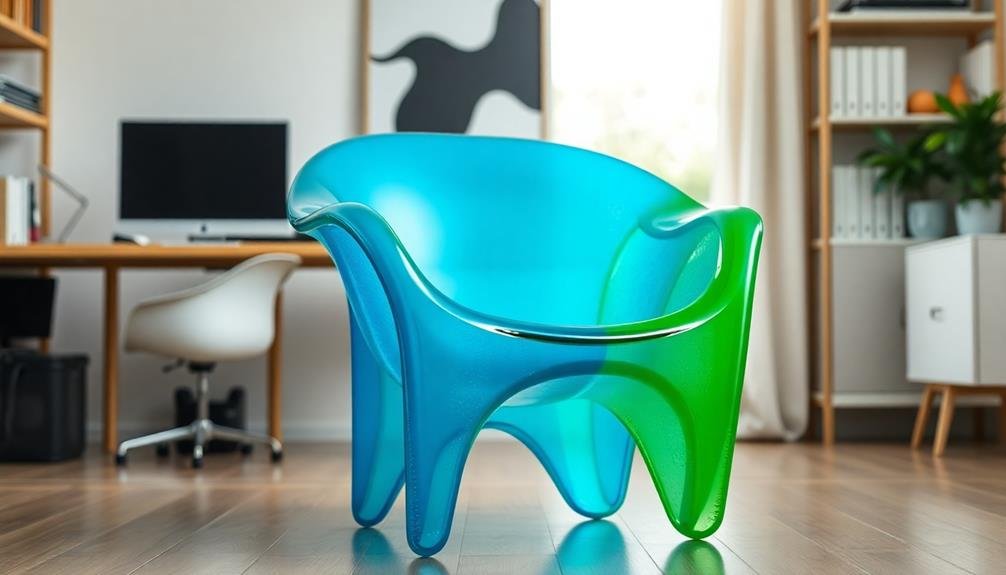
Ingenuity meets sustainability in the recycled plastic bottle chair, a creative solution for eco-conscious home office workers. You'll transform discarded plastic bottles into a functional, comfortable seat while reducing waste. Start by collecting 50-100 clean, empty bottles of the same size and shape.
Cut the bottles in half, keeping the bottom portions. Arrange these in a circular pattern, securing them with strong adhesive. Build up layers until you've created a sturdy base and backrest. For added comfort, cover the structure with recycled fabric or an old blanket.
To enhance your chair's appeal and functionality, consider these emotional benefits:
| Benefit | For You | For the Environment |
|---|---|---|
| Pride | DIY accomplishment | Reducing plastic waste |
| Comfort | Customized seating | Less demand for new furniture |
| Style | Unique conversation piece | Inspiring others to recycle |
| Savings | Low-cost project | Conserving resources |
You'll need patience and creativity to complete this project, but the result is a one-of-a-kind chair that showcases your commitment to sustainability. As you work from home, you'll sit comfortably knowing you've made a positive impact on the environment.
Natural Rattan Swivel Chair
Rattan, a versatile and sustainable material, offers a natural alternative for your DIY home office chair. It's lightweight, durable, and environmentally friendly, making it an excellent choice for eco-conscious DIY enthusiasts.
To create your own rattan swivel chair, you'll need to source high-quality rattan poles, a swivel mechanism, and natural fibers for weaving.
Begin by constructing the chair's frame using rattan poles, ensuring it's sturdy and comfortable. Attach the swivel base to provide smooth rotation and mobility. Then, weave the seat and backrest using rattan or other natural fibers, creating a supportive and breathable surface.
Here are some benefits of a natural rattan swivel chair:
- Eco-friendly and biodegradable
- Lightweight and easy to move
- Naturally resistant to mold and mildew
- Adds a tropical, bohemian touch to your office
- Can be customized with cushions or paint
With proper care, your DIY rattan swivel chair will last for years, providing a sustainable and stylish seating option for your home office.
Remember to oil the rattan occasionally to maintain its flexibility and prevent cracking, ensuring your chair remains comfortable and functional.
Salvaged Tire Ottoman
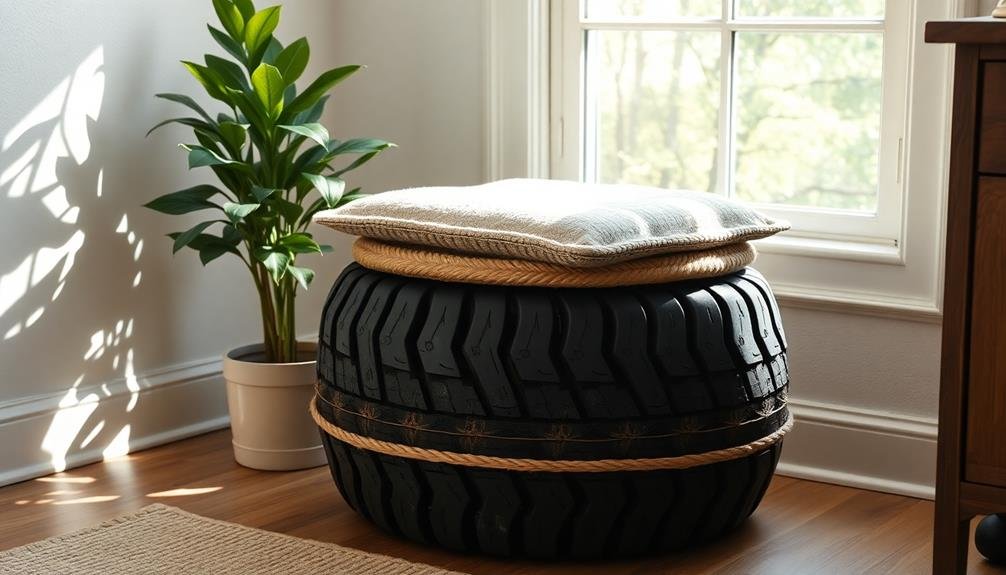
Transform an old, discarded tire into a functional and eco-friendly ottoman for your home office. This upcycling project not only reduces waste but also creates a unique, comfortable seating solution.
Start by thoroughly cleaning the tire and removing any metal parts. Next, wrap the tire with foam padding, securing it with adhesive. Cover the padded tire with your choice of durable fabric, such as canvas or recycled leather, using a staple gun to attach it firmly.
To create a stable base, cut a circular piece of plywood slightly larger than the tire's diameter. Attach short wooden legs to the plywood, then secure the covered tire to this base.
For added comfort and style, create a cushioned top by cutting a circular piece of high-density foam to fit the tire's opening. Cover this foam with matching or contrasting fabric, then attach it to the tire using strong adhesive or by sewing it in place.
You can customize your ottoman further by adding storage space inside the tire or incorporating decorative elements like braided rope or recycled buttons.
This DIY salvaged tire ottoman offers a sustainable seating option while adding character to your home office space.
Biodegradable Mushroom Foam Cushion
You'll find creating a biodegradable mushroom foam cushion is an eco-friendly alternative for your DIY office chair.
Start by growing the mushroom foam material, then mold it into your desired cushion shape.
Once you've achieved the perfect form, you'll need to know some finishing and maintenance tips to guarantee your cushion lasts.
Growing Mushroom Foam Material
Mushroom foam offers an eco-friendly alternative to traditional synthetic cushions. You can grow your own mushroom foam material at home, creating a sustainable solution for your DIY office chair.
To start, you'll need mycelium spores, organic substrate, and a mold for shaping the foam.
Begin by mixing the mycelium spores with the substrate, which can be agricultural waste like sawdust or corn husks. Pack this mixture into your desired mold shape, ensuring it's tightly compressed.
Place the mold in a dark, humid environment for about a week, allowing the mycelium to grow and bond with the substrate.
Once fully grown, remove the foam from the mold and bake it to stop the growth process. You'll now have a lightweight, durable, and biodegradable cushion material.
Here are some benefits of using mushroom foam:
- Completely biodegradable
- Naturally fire-resistant
- Excellent insulation properties
- Customizable density and shape
- Chemical-free production process
Molding Cushion Shape
After growing your mushroom foam material, the next essential step is molding it into the perfect cushion shape for your DIY office chair.
You'll need to create a mold that matches your desired cushion dimensions. Consider using recycled plastic or sustainably sourced wood to craft your mold, guaranteeing it's slightly larger than your final cushion size to account for shrinkage.
Once your mold is ready, gently break up the mushroom mycelium and substrate mixture. Press this material firmly into the mold, making sure to fill all corners and edges evenly. Use a flat tool to compress the mixture, removing any air pockets.
Cover the mold with a breathable fabric to allow for air circulation while maintaining moisture levels.
Place your filled mold in a dark, warm environment for 5-7 days. During this time, the mycelium will continue to grow, binding the substrate together.
Once the cushion has fully formed, carefully remove it from the mold. Allow it to air dry for 24-48 hours to stop the growth process.
Finishing and Maintenance Tips
With your biodegradable mushroom foam cushion ready, it's time to focus on finishing touches and long-term care.
To protect your eco-friendly cushion and extend its lifespan, consider applying a natural, non-toxic sealant. You can use beeswax, linseed oil, or a plant-based varnish to create a protective barrier against moisture and wear.
For maintenance, follow these tips to keep your mushroom foam cushion in top condition:
- Vacuum regularly to remove dust and debris
- Spot clean with a mild, eco-friendly soap and water solution
- Air out the cushion periodically to prevent moisture buildup
- Rotate the cushion every few months to guarantee even wear
- Store in a cool, dry place when not in use
Frequently Asked Questions
How Do Eco-Friendly Chairs Compare to Traditional Office Chairs in Terms of Durability?
You'll find eco-friendly chairs often match or exceed traditional office chairs in durability. They're built with sturdy, sustainable materials that can withstand daily use. Many eco-friendly options are designed for longevity, potentially outlasting their conventional counterparts.
What Certifications Should I Look for When Purchasing Sustainable Office Furniture?
You'll want to look for certifications like FSC for sustainably sourced wood, GREENGUARD for low chemical emissions, and BIFMA level for overall sustainability. Don't forget to check for recycled content and energy-efficient manufacturing certifications too.
Can Eco-Friendly Office Chairs Support People With Back Problems or Special Needs?
Yes, eco-friendly office chairs can support people with back problems or special needs. You'll find options with adjustable lumbar support, ergonomic designs, and customizable features. Look for chairs that use sustainable materials while prioritizing comfort and adaptability for your specific needs.
Are There Any Government Incentives for Businesses Using Sustainable Office Furniture?
You'll find some government incentives for sustainable office furniture. Check your local and federal programs for tax credits, grants, or rebates. They're often available for businesses investing in eco-friendly equipment, including office furnishings. It's worth investigating!
How Do I Properly Maintain and Clean Eco-Friendly Office Chairs?
You'll want to regularly dust and vacuum your eco-friendly chairs. Use mild, non-toxic cleaners for spot cleaning. Avoid harsh chemicals that can damage sustainable materials. Check manufacturer's guidelines for specific care instructions on your chair's unique materials.
In Summary
You've now explored a variety of eco-friendly seating options for your home office. By choosing sustainable materials and upcycling techniques, you're not only creating unique, comfortable chairs but also reducing your environmental impact. Whether you opt for a pallet chair, cardboard stool, or recycled plastic bottle seat, you're contributing to a greener future. Don't forget to contemplate natural fabrics and biodegradable cushions to complete your sustainable seating setup. Embrace these DIY projects and transform your workspace into an eco-conscious haven.

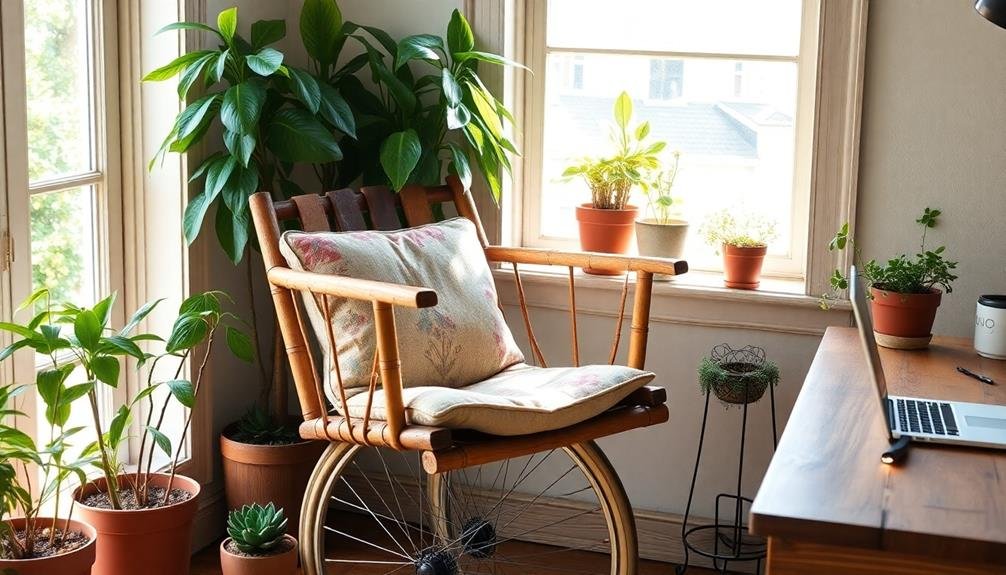
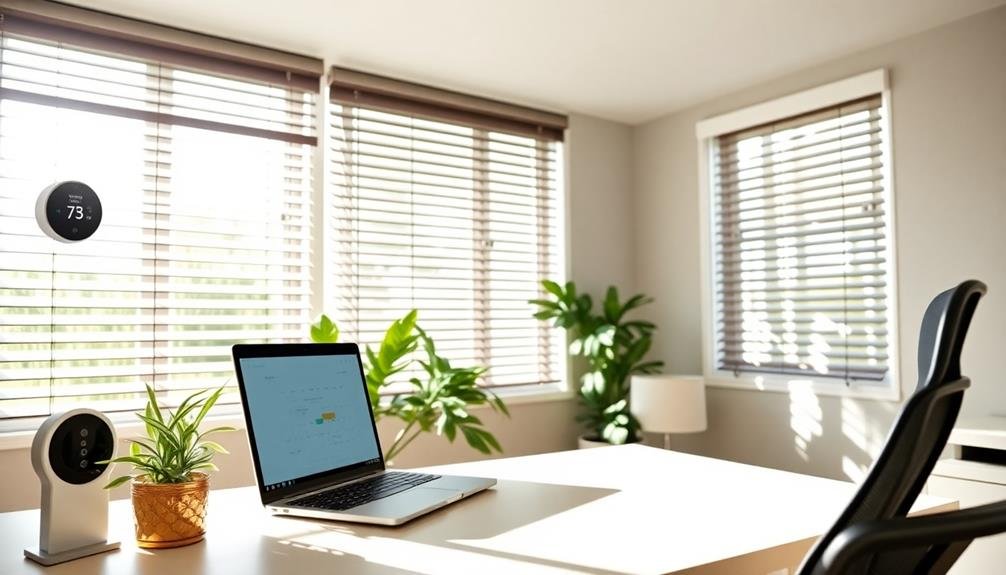
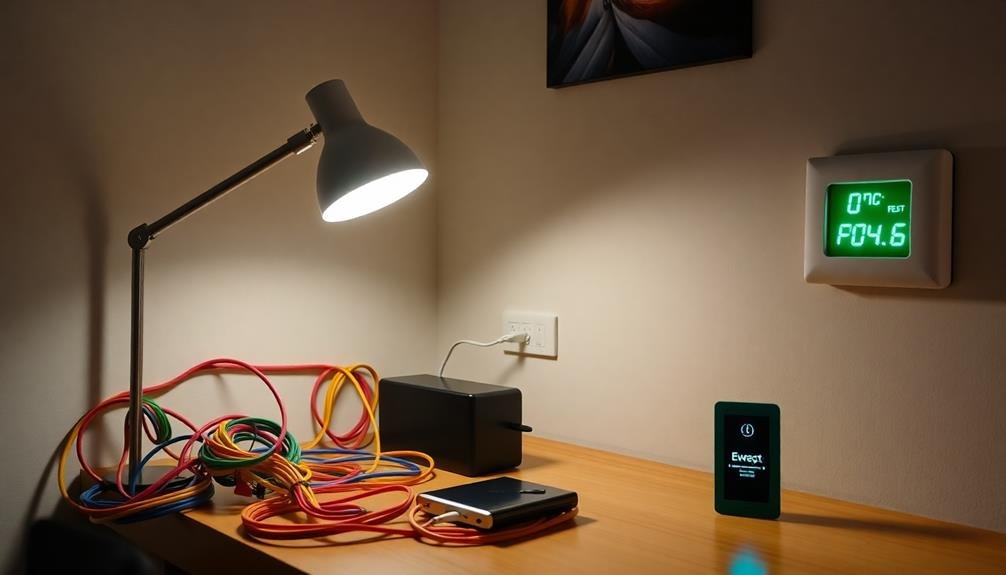
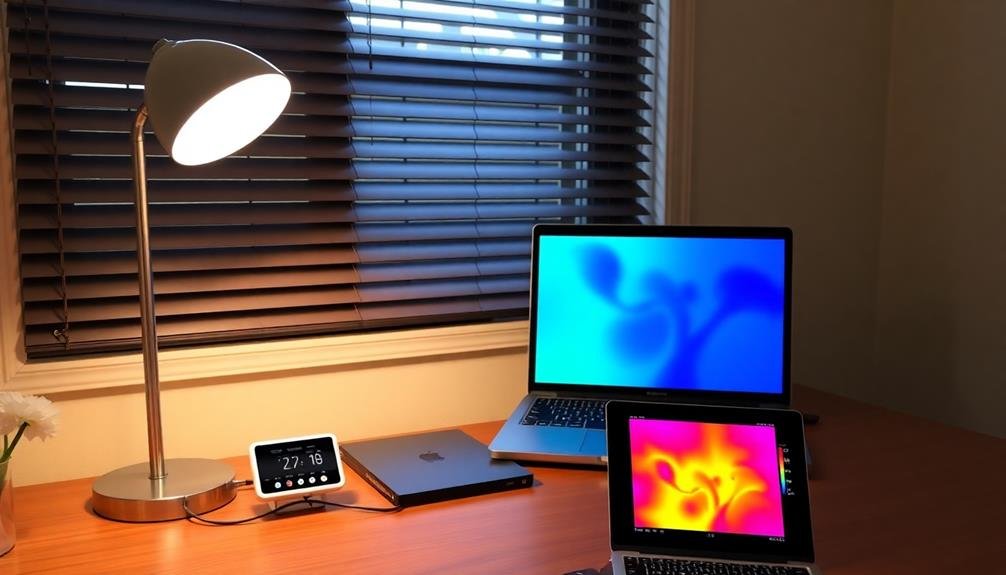
Leave a Reply